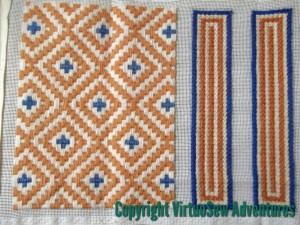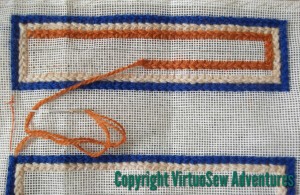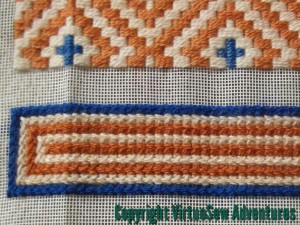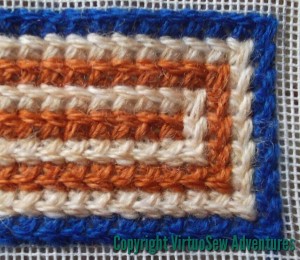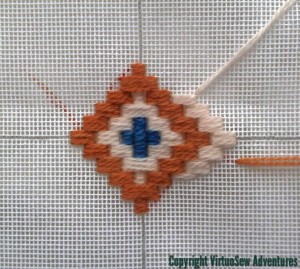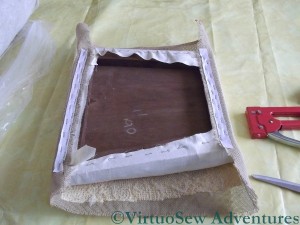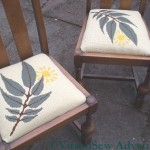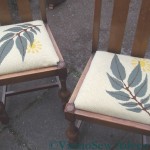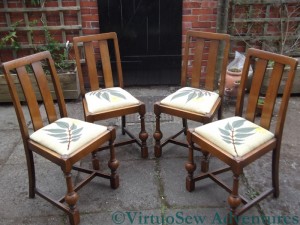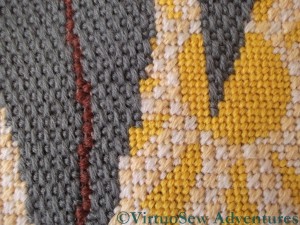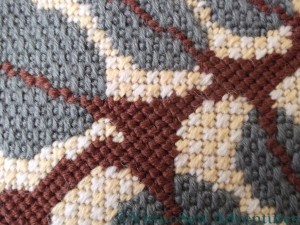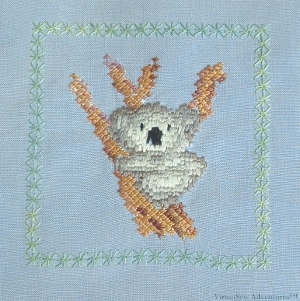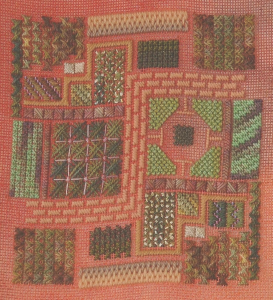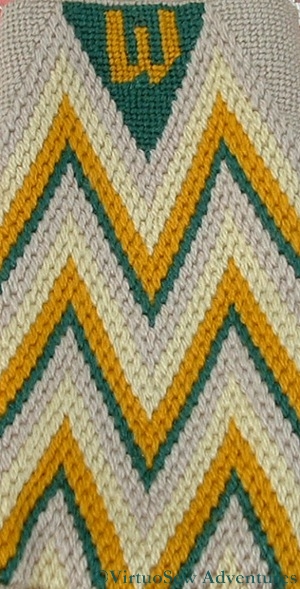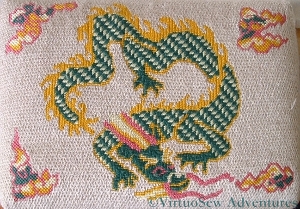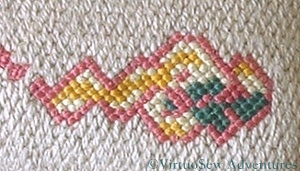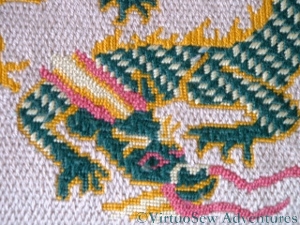Category: Needlepoint
The Chairs Are Finished!
You may recall that I decided to finish off the canvaswork seat covers for the dining room. That entailed, removing the existing corded velvet covers, so I decided to increase the padding on the seats while I was at it. So I added a couple of thick layers of cotton linterfelt, and covered it with calico.
I’ve had some real upholstery done recently, and the upholsterer told me that staple guns cause less damage to the wood than nails (obvious, when you think about it), so that’s what I used.
The staplegun has a kick like a mule, so the job had to be spread out over a couple of days. Getting the tacks out of the last set of covers took a day all by itself, so I have stapled it through some cotton tape, to prevent whatever I may use in the future catching on the threads of the canvas.
Eucalyptus Leaves in Canvaswork
I believe I have mentioned before that our house is rather Arts & Crafts flavoured. I’ve been working on our dining room almost since we moved in. It’s north-facing, and our predecessors had painted it pale blue and papered the ceiling turquoise with gold stars. We felt we were dining inside an iceberg!
That may explain why when I repainted it, the ceiling turned white and the walls sunshine yellow. Above the picture rail, I stencilled a eucalyptus leaf frieze (in deference to my husband The Australian). When in due course I inherited my Grandmama’s dining room table and chairs, I decided to work needlepoint covers for the seats.
Fortunately there are only four of them, but even so, I had to ask my mother to work on them as well, or they’d never have been finished. She helped with the stencilling as well – also an exciting challenge!
Unfortunately when they were finished I discovered some marks on some of the background. I was so dispirited that I couldn’t face unpicking them and so I stowed them away for several years. Now, however, I have fished them out, and I am tackling the replacement of some of the rows of stitching, one row at a time.
I would be nice to think I could get the chairs recovered for Easter…
A Canvaswork Koala
In fact this is worked on linen, but using canvaswork stitches. I was playing with some needlepoint charting software, in particular to find out how the stitches appeared on the chart and how easy it was to follow. I can’t remember where the Koala came from, whether he was originally in counted cross stitch or whether he was imported from a drawing. It is quite a simple design with relatively little modelling, and I’ve always been rather fond of it.
I used waste canvas to give me the stitch placement, and then simply worked the design according to the chart. The Koala himself is worked in straight stitches using stranded cotton, all six strands separated and made to lie side by side; the tree branch he is clinging to is worked in two shades of pearl cotton, using upright cross stitch (one of my favourites, as you know by now!), and the green frame of Algerian Eye stitches is worked in one of the Wildflowers threads from Caron Collection.
The embroidery has survived much better than the fabric it was stitched on. Originally I made a cushion cover, but the linen was already old before I started and now has holes in it. I’m going to do something with the Koala (suggestions please!) and then the rest will probably go into a rag rug…
The Canvaswork Abstract Garden
Following on from the Knot Garden, I decided to play a little more with the idea of using the canvas as a background, rather than covering it entirely. Since I already knew the canvas would not be covered, I chose a piece of dyed canvas (from “Kate’s Kloths”, which I haven’t been able to find online).
The first element was the simple path in expanded brick stitch, worked in wool. The rest of the panel was then built up as a pattern of varying stitches and threads. There was no predetermined idea, simply the aim of keeping a sense of balance and rhythm in the pattern densities. You will notice that block sizes and shapes are repeated, reflected across the path which snakes across the centre.
I’m not particularly comfortable with abstract work or even with designing it, so this repetition and reflection of the blocks was a way to give myself a structure for the piece. Otherwise I find abstract work often feels rather chaotic and it doesn’t offer me the chance to puzzle out “a good stitch to represent such-and-such”, which is where a lot of the fun of the Persian Fantasy came from.
This was an interesting exercise, but like the Knot Garden, it has remained as a piece of canvas, not mounted, framed or incorporated into anything, because I really haven’t a clue what to do with it!
Grandmama’s Dragon Footstool
I think that this was my first reasonably large canvaswork project, worked very early in my stitching career. The design was in the Readers Digest Encyclopedia of Needlework, which is a very good general introduction to a lot of styles of needlework, but needless to say, even at that early stage I made changes to both the design and the materials.
The Readers Digest suggested plain canvas – on the advice of my local needlepoint stop, I used interlock. The project pages said Tapestry wool – again, on advice, I used Persian Wool (lovely colours, and a really gorgeous sheen). They said Tent stitch – ah well, you can guess what’s coming, can’t you! Oh, and the colours were all changed, too. I did paint the design onto the canvas, using my mother’s oil paints, but after that, almost all resemblance to the project in the book ended.
The ornaments in the corners were worked in Upright Cross Stitch, which creates a surprisingly heavy texture for such a relatively simple stitch. Looking at the design now (after my grandparents died, the footstool came back to me) I rather feel that the original designer didn’t quite think things through. The corner motifs are all at different spacings from the dragon, and somehow the whole thing looks a bit congested. I think they may have designed for the round footstool bases that were popular at the time, and then added the corner motifs to make it more interesting for those who wanted a rectangular one. Nowadays, of course, I would try to have the courage of my convictions, and remove something or change the spacing, or alter the motifs to create a more pleasing effect. But a printed book looks so authoritative, doesn’t it – not for experimentation. One lives and learns!
The scales on the dragon’s body were worked in Oriental Stitch, and the spines on his back in Kelim Stitch, worked vertically instead of horizontally. Small details like eyebrows and outlining were worked in tent stitch (I do occasionally make the simple choice!). The trailing beard and horns were worked in rows of Knotted Stitch.
I don’t think I would use the same stitches again, or at least, not in all cases. I think the Oriental stitch is at the wrong scale for the dragon’s body – it was certainly a nightmare to get the compensation right! – and the beard and horns in fact need a heavier and more distinctive texture. The Kelim Stitch spines work well, I think, and the corner motifs in Upright cross stitch are successful too. I hadn’t, at this point, worked Slow-and-Steady, and although pictures of the worked stitches give you an idea of the worked appearance, it really isn’t the same as having done it yourself.
Still, it was fun, and interesting, and at the time, Grandmama said she was very impressed!

